Two Approaches to Leading a Study
There are many ways to lead a group Bible study, but these notes equip you for two approaches in particular.
Discussion Studies: Launch Questions
One approach is for the group to have a single discussion lasting the full time of the Bible study.
Having read the passage and prayed, you launch the discussion with a single question. A good launch question opens up discussion, and has potential to lead into all parts of the passage.
The group will determine where the discussion goes next. You steer things, asking supplementary questions (to check meaning, to develop application, to summarise or to move the discussion on). Sometimes you will need to ask your launch question again part way through.
This approach gives the group maximal freedom to work through the text for themselves. You’re still leading. However, suppose the last three verses particularly grab the group and they want to start there, then let them do that. You would know (to continue this hypothetical example) that the appeal of those last three verses is their earthy application, but that those verses apply the character of God described in the opening section. So you would make sure the group doesn’t stay in the last three verses for their whole time.
This is the group going on their own hike. Two different groups could study the same passage, launching off with the same question, and yet have two entirely different discussions. One group could spend lots of time on applications the other group didn’t even touch on, and so on.
Let’s illustrate this with a few diagrams. This first diagram represents what these notes give to equip you.
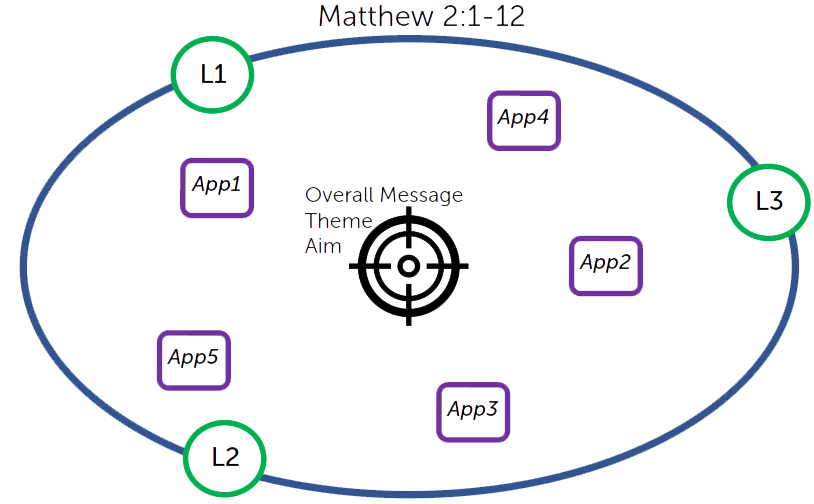
In the middle is what you’re aiming at (an overall message, theme and aim for the study). The oval indicates the area the passage covers, where the discussion could roam. Around the edge, you see three possible launch questions, to start the study going. Dotted around, are various applications the discussion might draw out.
As one group has this Bible study, things might run like this:
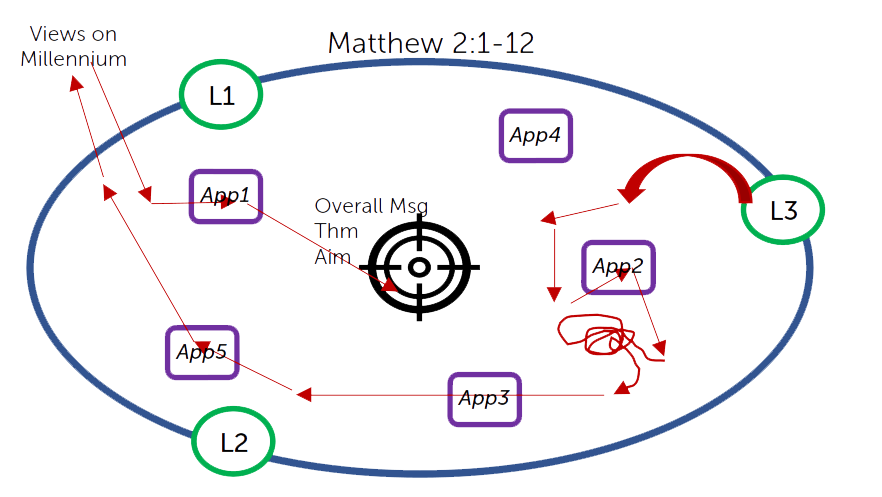
The group leader chose Launch Question 3 to start, leading to a discussion that spent time on Application 2. The discussion then just noted Application 3 briefly, before spending time on Application 5. At this point, a group member found a way to lead into a discussion of different views of the millennial reign in Revelation 19, before the group leader steered things back on-topic to the passage in question, landing on Application 1 before finishing.
A second group, studying the same passage, could experience this:
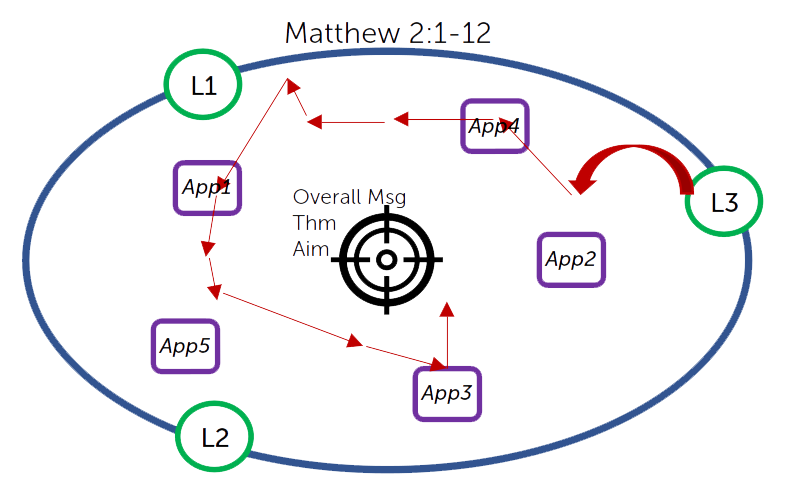
The group leader also chose Launch Question 3, but the details the group noticed in the passage led them to Application 4, and then to Application 1, then 3. The study didn’t end quite on the main point, but group studies often don’t. This second group didn’t even notice Applications 2 and 5, where the first group spent considerable time. Every study is different.
Structured Studies: Linear Questions
The other approach is to have a more structured time. Many published group Bible study resources are devised with this approach in mind.
Let’s say you have one hour for your Bible study. You might have 5 questions. Hypothetically, if the passage contained 5 paragraphs then each question could be looking at one of those paragraphs. The group would spend about 10 minutes considering the first question, before moving on to the next question, and so on.
This means that, instead of using a single “launch question” to kick off the entire study, you need a series (4-6?) of what I call “linear questions”, to lead the group through the passage step by step.
To use the group hike analogy, this is like planning your route from A to B via a series of short way-marks spaced every half-mile. The group enjoys the scenery of the forest section that comes first, pauses to catch breath, and then enjoys the cliff-top stretch that follows. The group won’t take an inland farm track that bypasses the cliff-path, because the route chosen is the one that does the forest and then the cliff.
This approach has some big advantages. It breaks down the task of the Bible study for the leader. If group members could go anywhere in the passage, ask anything, and notice any detail, it is a bigger task for the leader to hold in mind the overall aim of the study, and to respond to these unpredictable contributions. It also breaks the task down for the >group members, and this may particularly help certain groups or lend itself to certain passages. It can feel overwhelming to be asked a single question to launch into a long, unfamiliar or varied Bible passage. However, to break the passage into smaller units, and to ask a less ambitious question about each of those units, is to serve the group by helping them find the path.
Let’s show how this works in similar diagrams to before. Here is what these notes give to equip you:
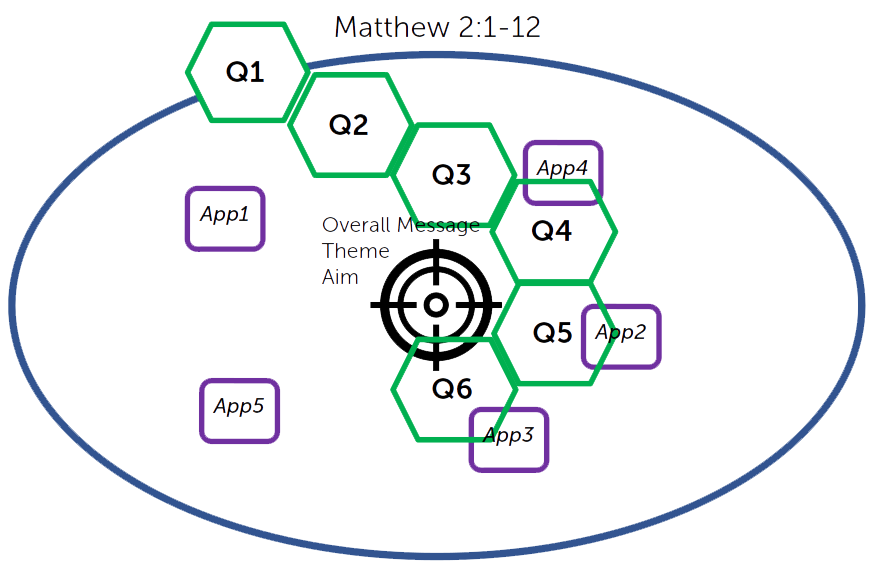
There is a series of 6 questions, the first of which starts outside the oval to lead into the ground covered by the passage. In a series of stages, the questions lead through different ground, converging on the main point of the passage and the study.
This study will not cover all the possible ground, but neither did either of the Discussion Studies. The difference here is that the questions largely determine what is and isn’t covered, rather than the group determining this as it goes.
The same 5 possible applications are shown on the diagram. Just as the study won’t cover all the ground, so it will spend time in 3 of the 5 possible applications. Once again, Discussion Studies did not cover all the possible applications, but the questions here determine which the group are likely to meet.
Here is how a study like this might work in practice:
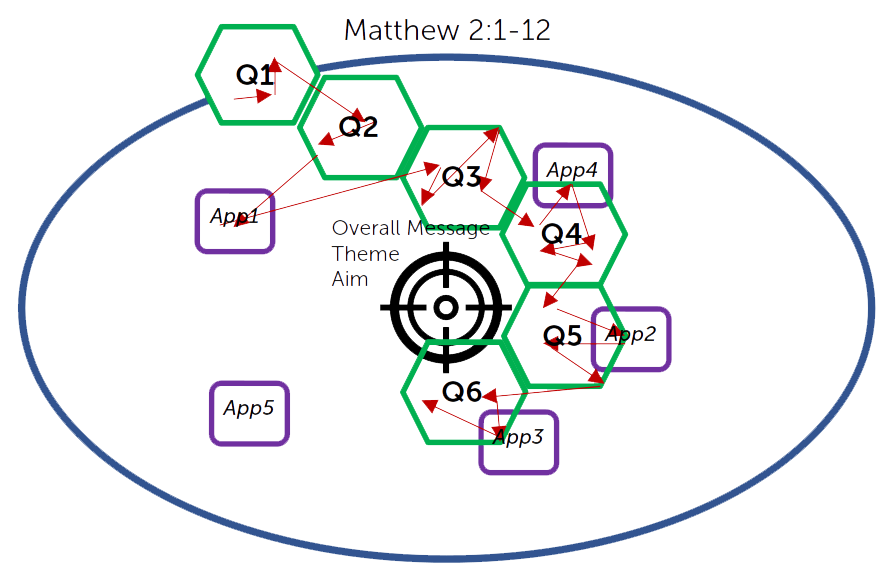
This doesn’t need much explanation, other than to note that this group did spend time on Application 1 after all. The questions may not have led the group there, but you still want to maintain freedom and control, so the group will notice details in the text that the questions don’t particularly signal. This is more than fine; this is a group Bible study, not a scripted lesson.
One Size doesn’t Fit All
For all the advantages of structured studies, there are disadvantages too. Structured studies, by their very nature, are further down the “control” end of the continuum from freedom to control. Discussion studies maximise the group’s sense of freedom, and therefore maximise the feeling of reward that they really have uncovered these truths themselves.
Discussion studies truly place the Bible into the hands of group members. If they return home, and during the week do their own Bible study on a chapter of another book of the Bible, they will discover they’ve learnt tools in their group study that can help them break into an unfamiliar portion of Scripture and mine it for themselves. Structured studies do this too, of course, but group members will feel most comfortable if they have a series of questions in front of them.
There is no right approach, and that is why these notes intentionally equip you to lead with either approach. Know your group. Know yourself. See how much time you have to prepare (but please don’t think either of these approaches lends itself to being unprepared). Then decide which approach you think will best serve the group you have, for the passage before you, in the week you’ll be studying it together.